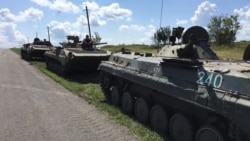Good morning. We'll start the live blog this week with an excerpt from a short, but succinct, editorial from The Guardian yesterday (originally published on the paper's website here):
It is a paradox of historic proportions: Vladimir Putin has done more to boost Nato’s territorial defence commitments than any Russian leader in decades. Nato has just carried out its biggest ever military exercise in Poland. Soldiers from nine European countries along with 440 tanks addressed the logistical challenges of responding to an attack from the east, in a scenario where foreign operatives and militias had fomented instability, while a hostile neighbour massed troops on the border. The implied reference to Russia’s tactics in Ukraine was stark. At last week’s summit, Nato indicated it would re-evaluate its nuclear strategy, a response to worrying nuclear signals from the Kremlin.
The spectacle of tanks rolling around in eastern Europe, and especially loose nuclear talk, rings alarm bells. And yet if Nato’s foundational logic is accepted – the logic of collective defence – the organisation can hardly turn a blind eye to Mr Putin’s recent run of threats, proxy military action and annexation of territory. Some sort of show of strength was inevitable. The important question is whether Nato opts for an unnecessary escalation of hostilities, a dangerous game of tit-for-tat, or a properly calibrated and proportionate response. US tanks and artillery are to be pre-positioned in the Baltic states, Poland, Romania and Bulgaria, and the US is ramping up Nato’s post-Ukraine rapid reaction force. These represent a greater US contribution towards Europe’s defence than at any time since the 1980s. Remarkably, this is happening under a US administration whose preferred focus has always been Asia. President Obama has been dragged into reversing George W Bush’s military drawdown in Europe out of concern for the task described by Nato’s first secretary general: “keeping the Americans in, and the Russians out” of the continent.
The Kremlin puts on a show of rage, but it can hardly be surprised. Nato has not rushed into this. Russia has recently flown nuclear-capable bombers over Europe, while failing to implement the Minsk ceasefire agreement. Its sabre-rattling is reshaping the strategic landscape. Nato’s moves were predictable, and have mostly been carefully metered. Pre-positioning equipment is not the same as creating permanent bases, and Nato thus keeps within the rules. Fighting continues in Ukraine, and Moscow has thousands of soldiers across the border, facing the Nato-enlisted Baltic states. The alliance can’t assume that Mr Putin will respect their borders until he knows that any transgression will meet a strong reaction. Dialogue must continue, but Russia should understand that escalation is a two-way street.
That concludes our Ukraine Live Blog coverage for today. Please join us again tomorrow.
The Ukrainian media is covering the protests in Armenia very closely, unfortunately the English-language media world is barely covering at all.




